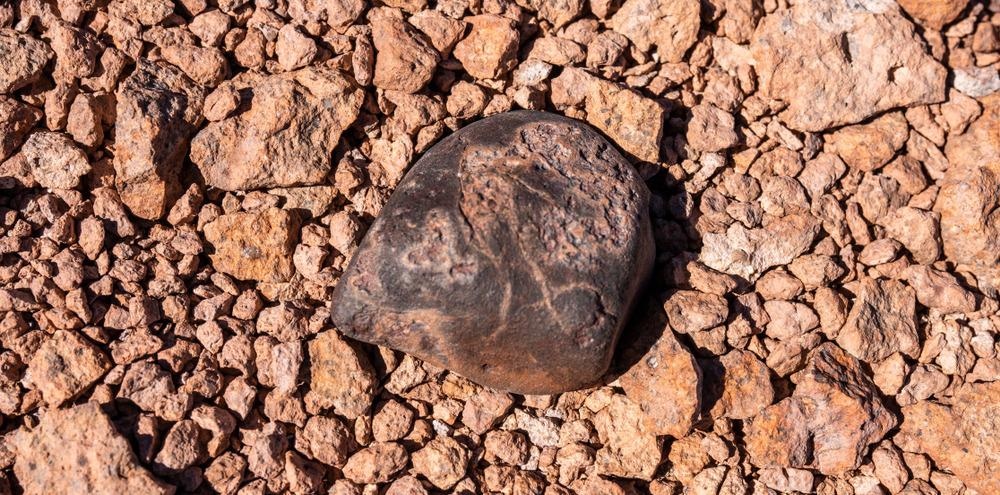An exciting discovery of a novel material, graphene, was found between two distinct meteorites. A team of scientists from NASA’s Johnson Space Center and the Carnegie Institution of Washington first discovered graphite embedded between these two structures which contain minerals that surpass the creation of the planets in the solar system. However, a decade and a revisit later, a more surprising discovery was made – evidence of novel material: graphene.

Image Credit: abriendomundo/Shutterstock.com
This reveal was made by Chaitanya Giri, an Indian-origin and ELSI Origins Network (EON) scientist at the Earth-Life Science Institute of Tokyo Institute of Technology, who revisited the same meteorites with the same scientific team. This article will explore the discovery of graphene and its significance.
What is Graphene?
Graphene is made up of a monolayer of carbon atoms which are tightly bound in the shape of a hexagonal lattice, or a honeycomb shape. Just like graphite, charcoal and diamond, graphene is also an allotrope of carbon, with graphene being the thinnest slice possible of graphite. Graphite can be formed with layers of graphene stacked on top of each other which would have an interplanar space of 0.335 nanometers.
This novel material can be classed as the thinnest compound known, which is one atom thick. It is also exceptionally light, with one square meter weighing approximately 0.77 milligrams. Other properties include being two-dimensional, having transparent characteristics, flexible, and has tremendous physical strength. Graphene is said to be stronger than steel, by approximately 100-300 times and has a tensile strength of 130 GPa, while also being an exceptional conductor of electricity and of heat at room temperature.
Graphene Publicity

Researcher holding a piece of graphene. Image Credit: BONNINSTUDIO/Shutterstock.com
The attention surrounding this novel material came to fruition when Andre Geim and Konstantin Novoselov were awarded the 2010 Nobel Prize in Physics for finding a method to isolate graphene. Prior to this study, graphene was only astronomically detected around dying stars using telescopes. The study involving Dr Giri used Raman spectroscopy to identify unambiguous signatures of graphene which was contained within the two meteorites that are approximately 4.5 billion years old.
Laboratory-made synthetic graphene is created under controlling and restrictive conditions, however, the naturally occurring graphene found within the meteorites consisted of structural deformities due to the nature of being in outer space.
There are two main ways to produce graphene - exfoliating carbon layers from graphite or using a substrate such as copper or nickel to deposit a precursor that contains carbon through chemical vapour deposition.
Importance of Graphene
The significance of this discovery lies in the reality of naturally occurring graphene within extra-terrestrial materials. Dr Giri states that this “detection can be considered as one of the stepping stones in this illustrious history of carbon-focusing cosmochemistry”. This discovery comes after other naturally occurring carbon-based materials were also found, with scientists uncovering fullerenes, nanodiamonds, pre-solar carbon that is older than the sun as well as graphite in meteorites.
Due to the importance of carbon in everyday life, its allotropes such as graphene are beneficial and almost integral to higher functioning in advanced fields. Carbon is the second most abundant mass in the body and the fourth most abundant element in the universe after hydrogen, helium and oxygen, based on mass, and so using a form of this element, which is the chemical basis for all life, would allow for advancements in various fields in an eco-friendly and sustainable way.
Applications
The applications for the novel graphene material lie in its use for electronics, semiconductors, advanced materials, as well as for space and space-based manufacturing industries. Many countries have already invested multi-billion dollars into research for the development of graphene.
The creation of supercapacitors using graphene would be the largest step in electronic engineering, as it would revolutionize the development of electronics, which, although has had a high rate of progression, is still limited by power capacity and efficiency. While lithium-ion batteries are very beneficial for electronics and semiconductors, there is still a trade-off between energy density and power density.
However, the use of laser-scribed graphene supercapacitors has demonstrated power density comparable to high-power lithium-ion batteries in initial tests, with additional benefits of being highly flexible, light, quick-to-charge, thin and inexpensive, and longevity in use.
Graphene can be used as an anode in lithium batteries in the form of graphene tin oxide and that alone would enable batteries to have a longer-lasting life between charges, up to 10 times. With the use of graphene, electronic items which can take hours to charge may only take seconds or minutes, and this application can also be used for powering electronic vehicles and other futuristic devices.
The discovery of graphene within the two meteorites makes for a “compelling study,” commented Dr Giri, as there was a distinct difference between the natural one found and the synthetic ones that are made in the laboratory. He added that “a large natural reservoir of graphene will be of interest to cosmochemists and planetary scientists, and also to space startups and all these industries. It is important to comprehend, outer space is a treasure trove of exotic chemicals and materials. We must explore space for them and our curiosities and necessities”.
Dr Giri and his team hope that this discovery illustrates the potential of finding further presence in minerals on carbonaceous asteroids, comets and even the moon, which could be confirmed with samples being brought back after advanced space missions.
References and Further Reading
The Indian Express. 2021. Discovery: Study involving Indian origin scientist finds graphene in two meteorites. [Online] Available at: https://indianexpress.com/article/technology/science/discovery-study-involving-indian-origin-scientist-finds-graphene-in-two-meteorites-7339885/ [Accessed 9 June 2021].
Fuente, J., 2021. Graphene - What Is It? | Graphenea. [Online] Graphenea. Available at: https://www.graphenea.com/pages/graphene [Accessed 9 June 2021].
D. Ghuge, A., R. Shirode, A. and J. Kadam, V., 2017. Graphene: A Comprehensive Review. Current Drug Targets, 18(6), pp.724-733. https://doi.org/10.2174/1389450117666160709023425
Disclaimer: The views expressed here are those of the author expressed in their private capacity and do not necessarily represent the views of AZoM.com Limited T/A AZoNetwork the owner and operator of this website. This disclaimer forms part of the Terms and conditions of use of this website.